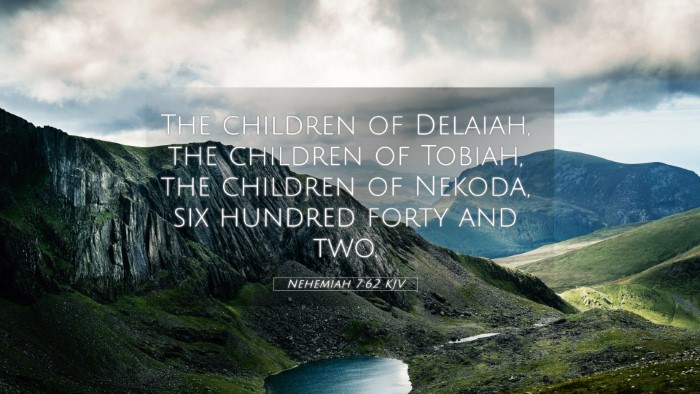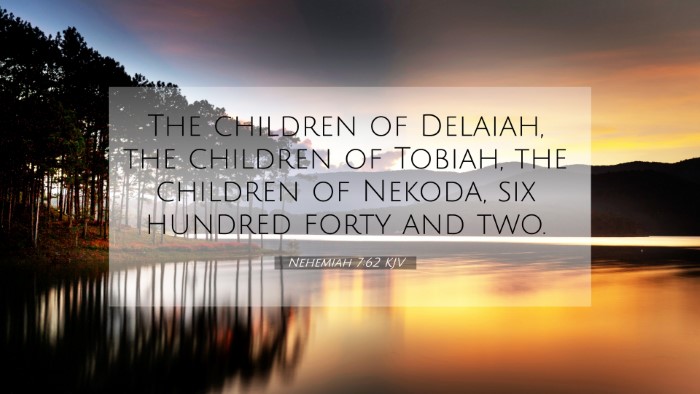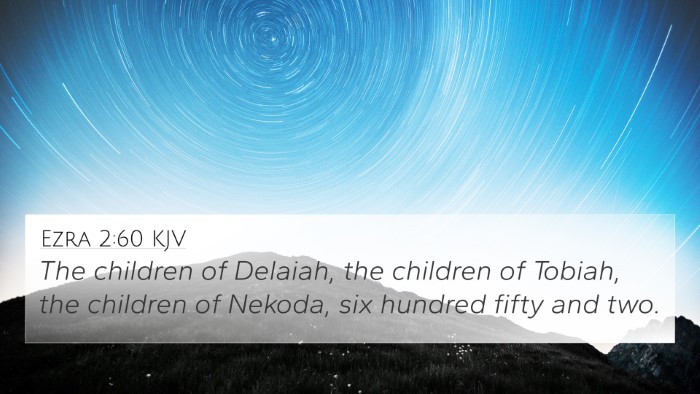Understanding Nehemiah 7:62
Nehemiah 7:62 states: "The children of Delaiah, the children of Tobiah, the children of Hakoz, the children of the children of the servants of Solomon." This verse lists names that pertain to those registered in the returned exiles from Babylon. The context encapsulates the effort of Nehemiah in ensuring proper organization and documentation for those who returned to Jerusalem after the exile.
Summary of Insights from Commentaries
- Matthew Henry: Henry highlights the importance of these names, indicating that they represent the covenant people of God. He points out that their listing signifies both their identity and their role within the restoration of Jerusalem. The mention of "servants of Solomon" reflects the continuity of God’s people across generations.
- Albert Barnes: Barnes interprets the lineage detailed in this verse to not only focus on ancestry but to underscore the significance of community and heritage within the larger framework of God’s redemptive work. He also notes that the records serve to validate the legitimacy of those returning from exile.
- Adam Clarke: Clarke emphasizes that the context of the exiles returning is critical to understanding this passage. He aligns the verse with themes of restoration and fulfillment of God’s promises, showcasing a plan that includes all facets of Israel’s heritage.
Thematic Cross-Referencing
Nehemiah 7:62 engages in a deeper narrative of God’s faithfulness and the ongoing story of Israel. The verse connects with several biblical themes and passages that highlight similar principles.
Related Bible Cross-References
- Ezra 2:61-62: This passage also mentions the same families and further details their role within the returned community.
- Nehemiah 7:5: This earlier verse provides context, where Nehemiah is appointed to take a census of the people.
- 2 Chronicles 36:22-23: Chronicles recounts Sheshbazzar’s decree which permitted the return of exiles, connecting to the hopes for restoration.
- Jeremiah 29:10-14: This prophetic word reminds the people of God's plan to restore them after their exile.
- Ezra 3:12: Some of the older priests and Levites wept when they saw the foundation of the new temple, revealing emotional ties to the past.
- Matthew 1:12: The genealogy in Matthew demonstrates the continuity from the Old Testament figures to the New Testament, linking back to the lineages mentioned in Nehemiah.
- Revelation 21:12: The names of the tribes of Israel are etched on the foundations of the New Jerusalem, symbolizing the eternal legacy of these families.
Connections Between Bible Verses
When studying Nehemiah 7:62, it is crucial to observe how it reflects broader themes found throughout both the Old and New Testaments.
- Continuity of Heritage: The verse emphasizes the lineage of God’s people, a theme that is mirrored in narratives such as Matthew 1, where genealogies affirm the lineage of Christ back to David.
- Restoration and Return: Themes of restoration resonate in several scriptures, particularly among the prophetic books—seeking to assure God’s people of His unwavering commitment.
- Community of Believers: The gathering of returnees connects to the New Testament understanding of the Church as the body of Christ.
Tools for Bible Cross-Referencing
To understand the connections and themes within Scripture, utilizing various bible cross-reference tools can be beneficial:
- Bible Concordance: A useful aid in finding words and themes throughout the Bible, allowing for deeper study into specific verses.
- Bible Cross-Reference Guide: These guides help track themes across different Biblical texts.
- Cross-Reference Bible Study Methods: Engaging in methods that utilize thematic and geographical cross-referencing to connect scriptures can enhance understanding.
Inter-Biblical Dialogue
Through cross-references, one can draw profound insights about God's overarching narrative. The connections found between different books of the Bible guide believers in understanding His intentions and fidelity. For instance:
- The Old Testament emphasizes God’s dealings with His chosen people, establishing a foundation that the New Testament then builds upon through Christ.
- Understanding the context given in the Pentateuch about the origins of the people adds depth to Nehemiah’s recounting.
- Exploring the Psalms in light of the historical narrative illuminates the prayers and laments of a people both assured of their restoration yet burdened by their history.
Conclusion
Nehemiah 7:62 serves not only as a list of names but as a critical intersection within the biblical narrative that reflects God's faithfulness, the importance of heritage, and the collective identity of God's people. By employing comprehensive Bible cross-reference materials and engaging in cross-referencing Bible study, one can gain a richer understanding of not only this verse but of the Scripture as a whole.



